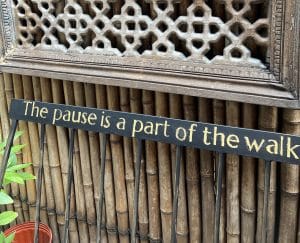
This week, we talked about the epic popularity of the idea of “disruption” in the business (and business school) world lately, and explored the difference between our interest in being “disruptive” in evolving our industry, our certain business norms, and our interest in taking that same approach to our personal growth. It’s all about progress, right?
Easier said than done when it comes to our individual selves. Buuuut, that doesn’t mean you aren’t going to give it your best MBA-level shot.
Your “no-fail” mindfulness challenge for this weekend is a fairly straightforward one, but it touches on some complex stuff. As always, you’ll need your 3 basic ingredients: your attention, your intention, and your breath. This time, you’ll also need a timer. (If you have a phone, which I know you do, then you have one.)
Let’s get started:
- Decide on a mindfulness activity of your choice. Maybe a seated guided meditation (see some options at the bottom of this page, or give the search over to Google), take a mindful walk, do some yoga, engage in a visualization exercise, as just a few possibilities.
- Before you begin, decide how long you are willing to commit to it. Any amount of time is fine, but once you decide, you’re going to stick with it.
- Oh, except for also, you’re going to add one minute to it. If you decided on 5 minutes, now it’s going to be 6. And you know how math works, so if you chose a different amount of time, I’ll let you figure it out from here.
- Set your timer, and get started. Find your point of focus – whether it’s your breath, movement, or something you’re envisioning, and connect with it. If you start noticing that your mind is full of thoughts that it would like you to engage with, that’s ok. It’s doing its job, and doing it well. Your job here is to gently and intentionally come back to your point of focus. Resist the temptation to get mad about it, and just come back.
- If you slip away again, just come back. Come back as often as you need to, because as you’ve heard me say before, that is in fact the meditation. You noticed, you made a choice, and you reclaimed your attention. That is
- When you start to notice a little corner of one of your eyelids trying to slyly check out how many minutes are left on your clock, that’s ok. Tell yourself it’s alright to look, but in a second. You’re not going to do it right now, because you may want to but you know you don’t have to. The timer is keeping track of the time. You don’t have to. When it’s time to stop, it will tell you so. It’s there for you, and it will keep you on track. Your brain can let that go, for now.
- When the timer rings, take a deep breath. Then, take a moment to reflect on how long that period of time seemed in relation to how long it actually was. Your answer may depend on how present you were able to stay in the exercise today, since a wandering mind loses time while a present mind is immersed in every morsel of it.
Regardless of how it went down today, it’s ok. It is exactly what it is, and whether you liked it or not, it will not be same tomorrow. When, by the way, I strongly recommend you try this one again.
The ability to stay present for one minute, or even one breath, longer than we really want to can be a deeply insightful experience. To me, it is at the heart of why mindfulness matters. Recognizing that you don’t have to flee from discomfort the moment you start to sense it – that you have a choice about what you do with it and when – is an incredibly powerful piece of self-knowledge. It is, in fact, power itself.
And to think, all you needed to do to discover it was catch your breath. The potential for what comes next is unlimited.
Photo credit: Alessio Soggetti



